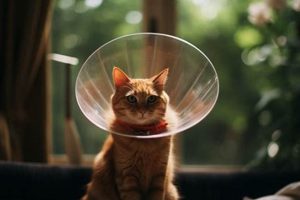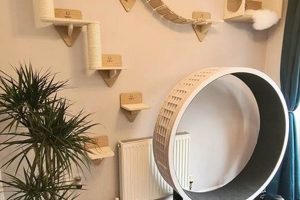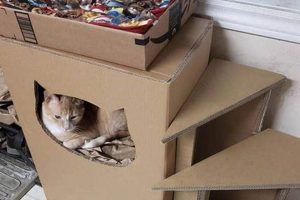Enclosures designed and constructed by individuals to conceal and integrate a feline’s sanitation area within a home’s dcor are referred to as self-made cat waste containment structures fashioned to resemble furniture. An example includes a modified cabinet or repurposed table concealing a standard litter box, offering a more aesthetically pleasing solution than a standalone tray.
Creating such solutions provides pet owners with opportunities to customize the appearance and functionality of litter areas, mitigating odors and minimizing visual disruptions. Historically, concealing litter boxes has evolved from simple screens to elaborate pieces intended to blend seamlessly with home furnishings, addressing both practical and aesthetic concerns. These constructions can enhance hygiene and improve the overall living environment.
The following sections will address various aspects of constructing a concealed cat waste management solution, including design considerations, material selection, construction techniques, and ventilation strategies to promote a clean and attractive home environment for both humans and felines.
Construction Recommendations
Effective self-construction of a feline waste management enclosure necessitates careful planning and execution. The following recommendations address crucial aspects of the building process, ensuring durability, functionality, and feline acceptance.
Tip 1: Design for Accessibility. Ensure unimpeded access for both the cat and the owner. A sufficiently large entryway prevents feline hesitancy, while a removable top or easily accessible side panel simplifies waste removal and cleaning.
Tip 2: Prioritize Ventilation. Adequate airflow is critical for odor control. Incorporate vents, either passive or fan-assisted, to facilitate air circulation and minimize ammonia buildup within the structure.
Tip 3: Select Moisture-Resistant Materials. Employ materials such as sealed plywood, melamine, or plastic sheeting to withstand moisture exposure and prevent degradation from urine or spills. Untreated wood is susceptible to damage and odor retention.
Tip 4: Ensure Structural Stability. The constructed enclosure must support the weight of the litter box and any potential feline activity, such as jumping or climbing. Reinforce corners and edges with appropriate hardware and adhesives.
Tip 5: Consider Litter Containment. Design the entryway to minimize litter tracking. Features such as a recessed floor or a short ramp can help contain litter within the enclosure.
Tip 6: Integrate Cleaning Solutions. Incorporate storage for cleaning supplies, such as scoopers, bags, and disinfectants, within the enclosure to facilitate regular maintenance.
Tip 7: Camouflage Wiring (if applicable). If incorporating electrical components like fans or lighting, conceal wiring to prevent feline interference and ensure safety. Use appropriate strain relief and secure connections.
The effective implementation of these recommendations will yield a functional and aesthetically pleasing addition to the home environment, addressing both the practical needs of feline waste management and the design preferences of the homeowner.
The subsequent section will detail advanced considerations for enhancing the longevity and appeal of the self-constructed feline waste management enclosure.
1. Odor Mitigation
Odor mitigation constitutes a primary functional requirement in the design and construction of feline waste management enclosures. Controlling and minimizing unpleasant smells emanating from cat litter is critical for maintaining a comfortable and hygienic home environment.
- Ventilation Strategies
Incorporating ventilation is essential for reducing odor concentration. Passive ventilation relies on natural airflow through strategically placed vents, while active ventilation employs fans to exhaust odors and promote air circulation. The selection of ventilation strategy depends on the enclosure’s design and environmental conditions.
- Litter Type Selection
Different litter materials exhibit varying odor-absorbing capabilities. Clumping clay litter, silica gel crystals, and plant-based options each offer distinct odor control properties. The choice of litter should align with the enclosure’s design and the owner’s preferences regarding absorbency and disposal.
- Air Filtration Integration
Implementing air filtration systems within enclosures provides an additional layer of odor control. Activated carbon filters, for example, effectively capture and neutralize volatile organic compounds (VOCs) responsible for unpleasant odors. The inclusion of filtration enhances the enclosure’s ability to maintain a fresh-smelling environment.
- Material Permeability
The selected construction materials influence odor retention and diffusion. Porous materials, such as untreated wood, tend to absorb and retain odors, while non-porous materials, such as plastic or sealed wood, offer better resistance. The use of low-permeability materials minimizes odor penetration and facilitates easier cleaning.
These multifaceted approaches to odor mitigation collectively contribute to the overall effectiveness of feline waste management enclosures. A comprehensive strategy integrating ventilation, appropriate litter selection, air filtration, and non-permeable materials ensures a more pleasant living environment for both humans and felines when creating self-made cat waste containment structures.
2. Feline Accessibility
Feline accessibility, in the context of self-constructed cat waste management structures, denotes the ease with which a cat can enter, utilize, and exit the enclosed litter area. Insufficient accessibility directly correlates with reduced usage, potential behavioral issues, and a failure to realize the intended benefits of concealment. Cause and effect are demonstrably linked; a poorly designed entrance, for example, can deter a cat from using the litter box, leading to unsanitary conditions and compromised household hygiene. Accessibility is a crucial design component; without it, the enclosure serves no practical purpose.
Real-life examples illustrate this point: Enclosures with excessively high entry points may be inaccessible to older cats or those with mobility limitations. Similarly, narrow entrances or dark interiors can induce anxiety and avoidance. The practical significance of understanding feline accessibility lies in the ability to create enclosures that are readily accepted and utilized by cats, promoting consistent litter box habits and minimizing undesirable behaviors such as elimination outside the designated area. Practical applications include incorporating appropriately sized openings, ramps for senior animals, and sufficient internal lighting to foster a sense of security.
In summary, the design of self-constructed cat waste management structures must prioritize feline accessibility to ensure the enclosure’s functionality and acceptance. Overlooking this aspect can negate the benefits of concealment and lead to behavioral problems. Further research into feline behavioral patterns and physical limitations can further enhance the effectiveness of these enclosures, addressing challenges related to aging cats, multi-cat households, and cats with pre-existing health conditions, while linking design choices to the overarching goal of responsible pet ownership.
3. Material Durability
Material durability constitutes a critical factor in the self-construction of feline waste management enclosures. The longevity and functionality of such structures are directly influenced by the selection of robust and resistant materials capable of withstanding the environmental conditions inherent in a litter box environment. Compromised material integrity can lead to structural failure, odor retention, and increased maintenance demands.
- Moisture Resistance
Feline urine and cleaning solutions introduce significant moisture exposure. Materials exhibiting inherent moisture resistance, such as sealed plywood, melamine, or certain plastics, prevent water damage, warping, and the proliferation of mold and bacteria. Untreated wood, conversely, is highly susceptible to degradation and odor absorption. Real-world examples of poor material choices include particleboard constructions that quickly disintegrate in humid environments. The implications of selecting non-resistant materials include frequent repairs, reduced lifespan of the enclosure, and potential health hazards.
- Scratch Resistance
Felines often exhibit scratching behavior around their litter areas. Materials resistant to scratching, such as durable laminates or reinforced surfaces, maintain the enclosure’s aesthetic appeal and prevent damage that can compromise structural integrity. Softer materials, like thin veneers, are easily damaged, leading to unsightly scratches and potential splintering. Scratch resistance preserves the enclosure’s appearance and prevents the need for frequent refinishing or replacement.
- Chemical Resistance
Cleaning products used to maintain hygiene can contain harsh chemicals. Materials exhibiting resistance to common cleaning agents, such as disinfectants and detergents, prevent discoloration, erosion, and other forms of chemical damage. Incompatible materials can react negatively with cleaning solutions, leading to surface degradation and the release of potentially harmful compounds. Chemical resistance ensures the enclosure can be effectively cleaned without compromising its structural or aesthetic integrity.
- Impact Resistance
Accidental impacts or the weight of a cat jumping onto the structure can exert significant force. Materials with high impact resistance, such as solid wood or reinforced composites, withstand these forces without cracking or breaking. Brittle materials are prone to damage from even minor impacts, requiring costly repairs. Impact resistance ensures the enclosure remains structurally sound and safe for feline use over an extended period.
The collective influence of these durability factors underscores the importance of informed material selection when constructing feline waste management enclosures. Prioritizing moisture resistance, scratch resistance, chemical resistance, and impact resistance results in a more robust, hygienic, and aesthetically pleasing structure, maximizing its lifespan and minimizing maintenance requirements while linking practical choices to design preferences.
4. Design Integration
Design integration, within the context of self-constructed feline waste management enclosures, refers to the seamless incorporation of the functional structure into the existing aesthetic and spatial characteristics of a dwelling. This process transcends mere concealment; it encompasses a holistic approach to harmonizing the utilitarian object with the surrounding environment, mitigating visual discord and enhancing the overall ambiance of the living space.
- Architectural Harmony
This facet addresses the alignment of the enclosure’s design with the existing architectural style of the home. Examples include mirroring the trim details of existing cabinetry, replicating the color palette of the room, or adhering to the overall design language (e.g., modern, traditional, minimalist). Failure to achieve architectural harmony results in a visually jarring element that detracts from the room’s aesthetic appeal. The implications extend beyond mere aesthetics, potentially affecting the perceived value and coherence of the interior space.
- Spatial Optimization
Spatial optimization involves the strategic placement and sizing of the enclosure to maximize functionality while minimizing intrusion. Examples include utilizing underutilized corners, integrating the enclosure into existing furniture arrangements, or designing it to serve a dual purpose (e.g., a side table with integrated litter box). Poor spatial optimization leads to inefficient use of space, potentially impeding movement or disrupting the flow of the room. The implications include reduced living space and a compromised sense of openness.
- Material Congruence
Material congruence focuses on selecting materials that complement or match the existing materials within the room. This encompasses considering factors such as wood type, finish, texture, and hardware. For instance, if the room features oak furniture with brass hardware, the enclosure should ideally incorporate similar elements. Incongruent material choices create visual conflict and disrupt the sense of continuity. The implications include a diminished sense of cohesiveness and a perception of disharmony.
- Functional Aesthetics
Functional aesthetics refers to the integration of aesthetic considerations with the practical requirements of the enclosure. Examples include incorporating ventilation grilles that are visually appealing, using lighting to enhance both visibility and ambiance, or designing access panels that blend seamlessly into the overall design. Neglecting functional aesthetics results in an enclosure that may be visually pleasing but impractical to use or maintain. The implications include compromised functionality and reduced user satisfaction.
In conclusion, design integration in the context of self-constructed feline waste management enclosures involves a multifaceted approach to harmonizing functionality and aesthetics. By carefully considering architectural harmony, spatial optimization, material congruence, and functional aesthetics, it becomes possible to create enclosures that not only serve their intended purpose but also enhance the overall aesthetic appeal and spatial efficiency of the home. This holistic approach underscores the importance of viewing the enclosure not merely as a utilitarian object, but as an integral component of the living environment.
5. Maintenance Ease
Maintenance ease, in the context of self-constructed feline waste management enclosures, directly influences the consistent upkeep and hygiene of the unit, subsequently impacting the overall living environment. A complex or inaccessible design inevitably results in infrequent cleaning, leading to increased odor, bacterial proliferation, and potential feline aversion to the litter area. The cause-and-effect relationship is evident: an enclosure designed with difficult-to-reach corners or cumbersome access panels will receive less frequent and thorough cleaning than one designed for simplified maintenance. Therefore, designing for maintenance ease is not merely a convenience; it is a critical component for ensuring the long-term functionality and hygiene of the enclosure, promoting both feline and human well-being. Real-life examples include enclosures with fixed tops or intricate internal structures that impede thorough cleaning, contrasting with designs featuring easily removable trays or wipeable surfaces.
Practical applications derived from this understanding include the incorporation of features such as slide-out trays for effortless litter replacement, smooth and non-porous interior surfaces to facilitate cleaning, and easily detachable components for thorough disinfection. The integration of storage compartments for cleaning supplies directly adjacent to the litter area further streamlines the maintenance process. Moreover, the selection of materials exhibiting resistance to urine and cleaning agents minimizes the risk of degradation and simplifies stain removal. An informed approach to material selection and structural design can significantly reduce the time and effort required for routine maintenance, increasing the likelihood of consistent upkeep and prolonging the lifespan of the enclosure.
In summary, maintenance ease is an indispensable consideration in the self-construction of feline waste management enclosures. By prioritizing accessibility, incorporating user-friendly features, and selecting durable, easily cleaned materials, the resulting structure becomes not only aesthetically pleasing but also functionally sustainable. Overlooking this aspect inevitably leads to reduced hygiene, increased odor, and potential feline behavioral issues. A holistic approach that integrates design considerations with practical maintenance requirements is paramount for achieving a successful and sustainable solution for feline waste management. Addressing this ensures a harmonious coexistence between humans and their feline companions in a clean and odor-controlled living space.
Frequently Asked Questions Regarding Self-Constructed Feline Waste Management Enclosures
This section addresses common inquiries and misconceptions pertaining to the design, construction, and implementation of self-made cat waste containment structures.
Question 1: What are the primary benefits of constructing a feline waste management enclosure?
The construction of a designated feline waste enclosure offers several advantages, including enhanced odor control, improved aesthetic integration within the home environment, and reduced litter scatter. Furthermore, such enclosures can provide the feline with a sense of privacy and security.
Question 2: What materials are most suitable for constructing such an enclosure, and why?
Optimal materials include moisture-resistant plywood, melamine, or sealed wood. These materials mitigate water damage from urine and cleaning solutions, prevent odor absorption, and facilitate easy cleaning. Untreated wood is generally unsuitable due to its porous nature and susceptibility to bacterial growth.
Question 3: How can adequate ventilation be ensured within the enclosure to minimize odor?
Ventilation can be achieved through strategically placed vents or the integration of a small, low-noise fan. The implementation of activated carbon filters further enhances odor control by absorbing volatile organic compounds. The placement and size of ventilation elements should be determined by the dimensions of the enclosure and the ambient air circulation.
Question 4: What are the essential design considerations to ensure feline acceptance of the enclosure?
Key design considerations include an appropriately sized entrance to accommodate the cat’s physical dimensions, a well-lit interior to promote a sense of security, and a litter box of sufficient size to allow comfortable maneuvering. Gradual introduction to the enclosure is recommended to facilitate acceptance.
Question 5: How can the enclosure be effectively cleaned and maintained to prevent odor and bacterial growth?
Regular cleaning is essential. Litter should be scooped daily, and the entire enclosure should be thoroughly cleaned with a mild disinfectant solution at least once a week. Removable trays or panels simplify the cleaning process. Ensure thorough drying after cleaning to prevent moisture buildup.
Question 6: What are the primary safety concerns associated with the construction and use of such enclosures?
Safety concerns include the secure mounting of all components to prevent collapse or tipping, the use of non-toxic materials and finishes to avoid ingestion hazards, and the safe routing of any electrical wiring to prevent electrocution. Sharp edges or protrusions should be eliminated to prevent injury to the feline or owner.
These frequently asked questions highlight the essential considerations for successfully constructing and maintaining a functional and aesthetically pleasing feline waste management enclosure. Proper planning and execution are crucial for realizing the intended benefits and ensuring the well-being of both the feline and the owner.
The following section will delve into specific design plans and construction tutorials for various types of feline waste management enclosures.
Conclusion
The preceding sections have detailed critical aspects of “diy cat litter box furniture” encompassing design considerations, construction techniques, material selection, odor mitigation strategies, and feline acceptance factors. A functional and aesthetically integrated solution necessitates a comprehensive understanding of these elements to ensure both practicality and harmonious incorporation into the living environment. The emphasis on durability, accessibility, and hygiene underscores the importance of meticulous planning and execution.
Effective self-construction requires a commitment to quality and attention to detail. By carefully considering the principles outlined, individuals can create waste management solutions that enhance the quality of life for both themselves and their feline companions, fostering a cleaner, more aesthetically pleasing home environment. Further investigation into advanced filtration systems, ergonomic designs, and sustainable material options will likely drive future innovation in this domain.







